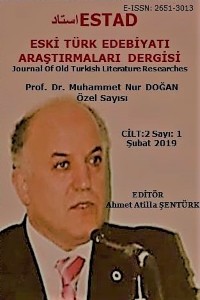Öz
One of the protectors of Turkish language and one of the founders of classical Turkish literature, the original expression of Âsık Pasha's wisdom called Garîb-nâme, the original expression of wisdom to the world, is the original sample of wisdom to truth. Because of its simplicity and success in using Sufi symbols and images, Âsık Pasha is one of the first poets to be considered when evaluating the symbols of classical Turkish literature. The human being who does not separate his existence from the existence of nature, who calls for all kinds of needs in nature, tried to answer the questions of his origins around the four elements. “Water, fire, soil, air” is four elements called the “anâsır-ı erbaa”, besides the mythological elements, is one of the basic images of classical Turkish literature. In the first part of this study; the reflections of the four elements of the body, expressed as “anâsır-ı erbaa, çehar anâsır” were evaluated in the Garîbnâme. In the second part of this study, it was emphasized that the land, water, fire and winds were used separately in Garîb-nâme.
Kaynakça
- ÇANKI, Mustafa Namık (1954). Büyük Felsefe Lugati, C. 1, İstanbul: Cumhuriyet Matbaası.
- ÇELİK, Değer (1994). Astroloji El Kitabı, İstanbul: Star Yaprak Yayıncılık.
- DEVELLİOĞLU, Ferit (2008). Osmanlıca Türkçe Ansiklopedik Lûgat, Ankara: Aydın Kitabevi Yayınları.
- ERDAL, Tuğçe (2017). “Halk Hikâyelerinde Aşk ve Erginlenme Tasarımında Anâsır-ı Erbaa”, Millî Folklor, Yıl 29, Sayı 115, s.s. 5-18.
- GÖKBERK, Macit (1994). Felsefe Tarihi, İstanbul: Remzi Kitabevi.
- HANÇERLİOĞLU, Orhan (1973). Felsefe Sözlüğü, İstanbul: Remzi Kitabevi. HARMANCI, Meriç (2014). “Kutlu Başlangıçtan Ebedî İstirahatgaha: Türk Tasavvuf Edebiyatında Toprak Algısı”, Divan Edebiyatı Araştırmaları Dergisi 13, İstanbul 2014, s.s. 23-38.
- KABLANDER, Nesibe (2016). “Üç Halvetî Şâirin Dîvânlarında Anâsır-ı Erbaa (Ateş, Hava, Su Ve Toprak) Unsurlarının Kullanımı Üzerine Bir İnceleme”, Turkish Studies, 11/5, s.s. 351-382.
- KARATAŞ, İbrahim Ethem (2014). “Erzurumlu İbrahim Hakkı’nın Marifetname’sinde Anâsır-ı Erbaa (Dört Unsur) Görüşü”, Muğla Sıtkı Koçman Üniversitesi Sosyal Bilimler Enstitüsü Dergisi, Sayı 33, 2014 Güz, 104-122.
- KARLIĞA, H. Bekir (1991). “Anâsır-ı Erbaa”, İslam Ansiklopedisi. C. 3, s.s. 149-151.
- LEVEND, Âgâh Sırrı (1968). “Halk ve Tasavvufî Halk Edebiyatı”, Türk Dili Dergisi, C. 19, S. 207, 1 Aralık 1968, s. 176.
- LEVEND, Âgâh Sırrı (2015). Dîvân Edebiyatı Kelimeler ve Remizler Mazmunlar ve Mefhumlar, İstanbul: Dergâh Yayınları.
- PALA, İskender (1999). “Mazmunun Mazmunu”, Osmanlı Dîvân Şiiri Üzerine Metinler (Haz. Mehmet Kalpaklı), İstanbul: Yapı Kredi, s. 399-402.
- PALA, İskender (2004). Ansiklopedik Dîvân Şiiri Sözlüğü, İstanbul: Kapı Yayınları.
- PALA, İskender (2010). Dört Güzeller, Toprak, Su, Hava, Ateş, İstanbul: Kapı Yayınları.
- ULUDAĞ, Süleyman (1991). Tasavvuf Terimleri Sözlüğü, İstanbul: Marifet Yayınları.
- YAVUZ, A. Fikri (2002), Kur’ân-ı Kerim ve Meâl-i Âlisi, İstanbul: Sönmez Yayınları.
- YAVUZ, Kemal (2009), Âşık Paşa Garib-nâme, Ankara: Türk Dil Kurumu Yayınları.
Öz
Türk dilinin hamilerinden ve klasik Türk edebiyatının banilerinden Âşık Paşa’nın Garîb-nâme adlı mesnevisi, kâinata hikmetle bakmanın öz bir ifadesi, hikmetten hakikate ermenin özgün bir numunesidir. Tasavvufi remizleri, imgeleri kullanmadaki sadeliği ve başarısı dolayısıyla Âşık Paşa, klasik Türk edebiyatının mazmunlarını değerlendirirken ilk müracaat edilmesi gereken şairlerden biridir. Kendi varlığını tabiatın varlığından ayırmayan, her türlü ihtiyacının karşılığını doğada arayan insanoğlu, öze ve cevhere dair soruları “dört element” etrafında cevaplamaya çalışmıştır. “Su, ateş, toprak, hava” unsurlarını tanımlayan anâsır-ı erbaa, düşünce tarihi boyunca üzerinde durulan, tartışılan, ontolojik bir mesele olmakla birlikte klasik Türk edebiyatının da temel mazmunlarındandır. Bu çalışmanın birinci bölümünde, “anâsır-ı erbaa, çehâr-anâsır” gibi tamlamalarla ifade edilen, âlemin ve âdemin temelini oluşturduğu düşünülen dört elementin Garîb-nâme’deki yansımaları; ikinci bölümünde ise toprak, su, ateş ve yelin Garîb-nâme’de müstakil olarak işlendiği beyitler üzerinde durulmuştur.
Kaynakça
- ÇANKI, Mustafa Namık (1954). Büyük Felsefe Lugati, C. 1, İstanbul: Cumhuriyet Matbaası.
- ÇELİK, Değer (1994). Astroloji El Kitabı, İstanbul: Star Yaprak Yayıncılık.
- DEVELLİOĞLU, Ferit (2008). Osmanlıca Türkçe Ansiklopedik Lûgat, Ankara: Aydın Kitabevi Yayınları.
- ERDAL, Tuğçe (2017). “Halk Hikâyelerinde Aşk ve Erginlenme Tasarımında Anâsır-ı Erbaa”, Millî Folklor, Yıl 29, Sayı 115, s.s. 5-18.
- GÖKBERK, Macit (1994). Felsefe Tarihi, İstanbul: Remzi Kitabevi.
- HANÇERLİOĞLU, Orhan (1973). Felsefe Sözlüğü, İstanbul: Remzi Kitabevi. HARMANCI, Meriç (2014). “Kutlu Başlangıçtan Ebedî İstirahatgaha: Türk Tasavvuf Edebiyatında Toprak Algısı”, Divan Edebiyatı Araştırmaları Dergisi 13, İstanbul 2014, s.s. 23-38.
- KABLANDER, Nesibe (2016). “Üç Halvetî Şâirin Dîvânlarında Anâsır-ı Erbaa (Ateş, Hava, Su Ve Toprak) Unsurlarının Kullanımı Üzerine Bir İnceleme”, Turkish Studies, 11/5, s.s. 351-382.
- KARATAŞ, İbrahim Ethem (2014). “Erzurumlu İbrahim Hakkı’nın Marifetname’sinde Anâsır-ı Erbaa (Dört Unsur) Görüşü”, Muğla Sıtkı Koçman Üniversitesi Sosyal Bilimler Enstitüsü Dergisi, Sayı 33, 2014 Güz, 104-122.
- KARLIĞA, H. Bekir (1991). “Anâsır-ı Erbaa”, İslam Ansiklopedisi. C. 3, s.s. 149-151.
- LEVEND, Âgâh Sırrı (1968). “Halk ve Tasavvufî Halk Edebiyatı”, Türk Dili Dergisi, C. 19, S. 207, 1 Aralık 1968, s. 176.
- LEVEND, Âgâh Sırrı (2015). Dîvân Edebiyatı Kelimeler ve Remizler Mazmunlar ve Mefhumlar, İstanbul: Dergâh Yayınları.
- PALA, İskender (1999). “Mazmunun Mazmunu”, Osmanlı Dîvân Şiiri Üzerine Metinler (Haz. Mehmet Kalpaklı), İstanbul: Yapı Kredi, s. 399-402.
- PALA, İskender (2004). Ansiklopedik Dîvân Şiiri Sözlüğü, İstanbul: Kapı Yayınları.
- PALA, İskender (2010). Dört Güzeller, Toprak, Su, Hava, Ateş, İstanbul: Kapı Yayınları.
- ULUDAĞ, Süleyman (1991). Tasavvuf Terimleri Sözlüğü, İstanbul: Marifet Yayınları.
- YAVUZ, A. Fikri (2002), Kur’ân-ı Kerim ve Meâl-i Âlisi, İstanbul: Sönmez Yayınları.
- YAVUZ, Kemal (2009), Âşık Paşa Garib-nâme, Ankara: Türk Dil Kurumu Yayınları.
Ayrıntılar
| Birincil Dil | Türkçe |
|---|---|
| Bölüm | MAKALELER |
| Yazarlar | |
| Yayımlanma Tarihi | 28 Şubat 2019 |
| Yayımlandığı Sayı | Yıl 2019 Cilt: 2 Sayı: 1 |













